Strategic Dilemmas Surrounding the Softest Tyre Choices at the Canadian Grand Prix
As the Canadian Grand Prix approaches, teams and drivers face a familiar challenge: selecting the optimal tyre compound for qualifying in Montreal’s unpredictable conditions. The availability of the softest rubber compounds, particularly the newly introduced C6 for 2025, has reignited debates about whether these tyres truly deliver the best performance or if a more conservative approach might be wiser.
The Evolution of Tyre Strategy: From Softest to Balanced
With Pirelli’s recent shift towards more aggressive tyre selections, the softest compounds are expected to provide a significant edge in single-lap speed. Theoretically, the C6 should outperform the C5 in qualifying, offering quicker lap times due to increased grip. However, the marginal difference between these compounds-often less than a tenth of a second-raises questions about their practical advantage, especially under rising track temperatures forecasted for Saturday.
Historically, similar situations have arisen in races at circuits like Imola and Monaco, where the softest tyres faced durability issues. For instance, in the 2022 Monaco GP, teams debated whether to push the limits of the softs or to switch to more durable mediums. The outcome often depended on tyre management and track conditions, with some drivers opting for the more conservative medium tyres to secure better overall performance.
Weather Conditions and Tyre Durability Concerns
Forecasts predict higher ambient temperatures during Saturday’s qualifying, which could compromise the integrity of the ultra-soft C6 tyres. Overheating risks are a real concern, potentially leading to reduced grip and increased degradation over a single lap. Consequently, teams might find it advantageous to reserve a set of medium tyres for the critical moments of qualifying, balancing speed with durability.
This approach mirrors strategies employed in previous races, where teams like Mercedes and Red Bull have opted to save their softer compounds for the race or final qualifying runs, aiming to maximize tyre life and performance consistency.
Insights from Practice Sessions and Team Preferences
During Free Practice 1, most teams adhered to the soft tyres, with only a handful experimenting with mediums or hards. Pirelli’s data indicates that nine out of ten teams have preserved two sets of hard tyres for the race, with Sauber being the exception, having used a set during FP2. The Swiss team believes that an extra set of C5s could prove beneficial on race day, especially given the unpredictable nature of tyre graining and degradation.
Drivers like Carlos Sainz have expressed skepticism about the reliability of the softer compounds, citing the narrow margin-around a tenth-between the tyre options as a source of potential chaos. Sainz emphasized that managing tyre load, particularly in the circuit’s high-power sectors, will be crucial to avoid overheating and loss of grip.
The Uncertainty of Tyre Management and Qualifying Tactics
Veteran driver Fernando Alonso highlighted the difficulty in predicting tyre performance, noting that the track’s evolving grip levels throughout the weekend complicate decision-making. With FP1 and FP2 considered less critical, teams are eager to gather more data in FP3 to refine their strategies.
Pierre Gasly echoed this sentiment, suggesting that teams are primarily focused on optimizing their car setups rather than committing to a definitive tyre choice. The key will be balancing the potential gains from using the softer tyres against the risk of overheating and graining, which could compromise qualifying runs.
The Role of Tyre Graining and Race Predictions
Pirelli’s chief engineer, Simone Berra, acknowledged that tyre graining has been a significant issue during practice, though improvements are anticipated as the circuit gains more rubber. He indicated that a two-stop race strategy appears most promising for Sunday’s 70-lap event, with both medium and hard tyres showing resilience during long stints.
Berra’s insights suggest that teams might lean towards a conservative approach, reserving the softer compounds for critical moments while relying on the durability of the mediums and hards. The ongoing analysis of tyre behaviour will be vital in determining whether a one-stop or two-stop race strategy will prevail.
Looking Ahead: The Unfolding Tyre Strategy
As teams continue to analyze data from Saturday’s final practice, the decision on whether to push the limits with the C6 or adopt a more measured approach remains open. The evolving track conditions, combined with the inherent unpredictability of tyre behaviour, will shape the qualifying and race strategies in Montreal.
In summary, the Canadian Grand Prix presents a complex puzzle of tyre management, where the choice between speed and durability could ultimately decide the outcome. With the potential for a two-stop race and the risk of tyre graining, teams must carefully weigh their options to maximize performance in this challenging street circuit.

